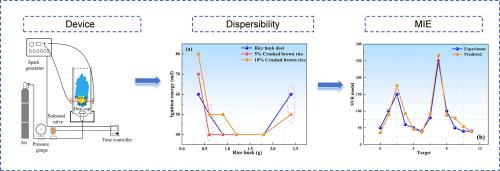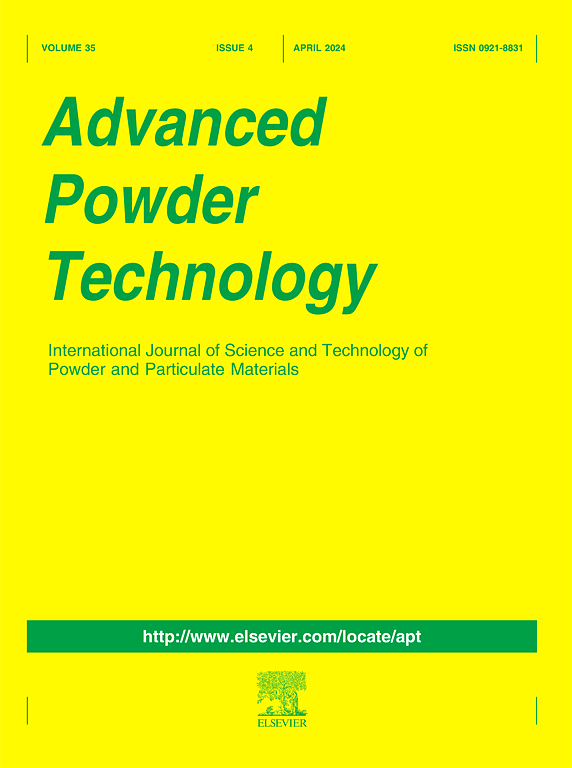基于碾碎糙米含量的谷壳粉尘点火能预测的XGBoost机器学习建模与SVR
IF 4.2
2区 工程技术
Q2 ENGINEERING, CHEMICAL
引用次数: 0
摘要
稻壳粉尘在生产和运输过程中存在粉尘爆炸的危险。阐明粉尘云的最小点火能量(MIE)参数对降低粉尘爆炸具有重要意义。本研究探讨糙米碎(简称糙米碎)包合比例对稻壳粉尘云MIE的影响。研究发现,随着糙米粉的掺入,稻壳粉的MIE呈增加趋势。然而,少量碾碎的糙米可以改善粉尘云的分散,从而降低其点火能量,增加粉尘爆炸的风险。此外,利用极端梯度增强算法(XGBoost)和支持向量回归算法(SVR)两种机器学习建模方法对稻壳的MIE进行建模。采用网格搜索对超参数进行自动优化。在模型最优状态下,SVR模型的R2值为0.913,高于XGBoost模型的0.883,同时预测误差更小,说明SVR模型更适合于稻壳MIE的研究。因此,谷物粉尘的加工和运输应考虑到这些发现。本文章由计算机程序翻译,如有差异,请以英文原文为准。

Machine learning modeling of XGBoost and SVR for predicting rice husk dust ignition energy based on crushed brown rice content
There exists the risk of dust explosion during the rice husk dust production and transportation. It is of great significance to clarify the parameter of the minimum ignition energy (MIE) of the dust cloud for reducing the dust explosion. This study explored the influence of the inclusion proportion of crushed brown rice (abbreviated as crushed brown rice) on the MIE of rice husk dust cloud. It was found that with the incorporation of crushed brown rice, the MIE of rice husk dust showed an increasing trend. However, a small amount of crushed brown rice can improve the dispersion of dust clouds, thereby reducing their ignition energy and increasing the risk of dust explosions. Moreover, two machine learning modeling methods, namely the Extreme Gradient Boosting algorithm (XGBoost) and the Support Vector Regression algorithm (SVR), were utilized to model the MIE of the rice husk. The grid search was employed to automatically optimize the hyperparameters. In the optimal state of the model, the R2 value of the SVR model, which is 0.913, is higher than that of the XGBoost model, which is 0.883, and the prediction error is lower at the same time, thus demonstrating that the SVR model is more suitable for the study of the MIE of the rice husk. Grain dust processing and transportation should therefore take these findings into consideration.
求助全文
通过发布文献求助,成功后即可免费获取论文全文。
去求助
来源期刊

Advanced Powder Technology
工程技术-工程:化工
CiteScore
9.50
自引率
7.70%
发文量
424
审稿时长
55 days
期刊介绍:
The aim of Advanced Powder Technology is to meet the demand for an international journal that integrates all aspects of science and technology research on powder and particulate materials. The journal fulfills this purpose by publishing original research papers, rapid communications, reviews, and translated articles by prominent researchers worldwide.
The editorial work of Advanced Powder Technology, which was founded as the International Journal of the Society of Powder Technology, Japan, is now shared by distinguished board members, who operate in a unique framework designed to respond to the increasing global demand for articles on not only powder and particles, but also on various materials produced from them.
Advanced Powder Technology covers various areas, but a discussion of powder and particles is required in articles. Topics include: Production of powder and particulate materials in gases and liquids(nanoparticles, fine ceramics, pharmaceuticals, novel functional materials, etc.); Aerosol and colloidal processing; Powder and particle characterization; Dynamics and phenomena; Calculation and simulation (CFD, DEM, Monte Carlo method, population balance, etc.); Measurement and control of powder processes; Particle modification; Comminution; Powder handling and operations (storage, transport, granulation, separation, fluidization, etc.)
 求助内容:
求助内容: 应助结果提醒方式:
应助结果提醒方式:


